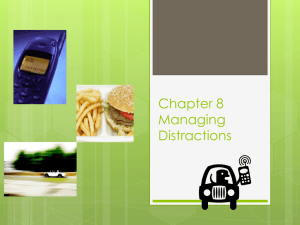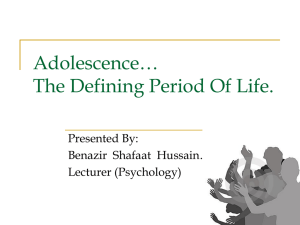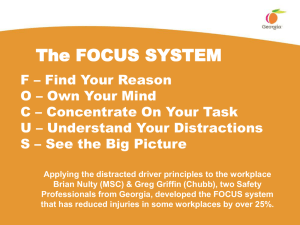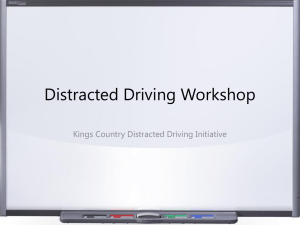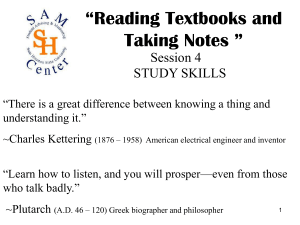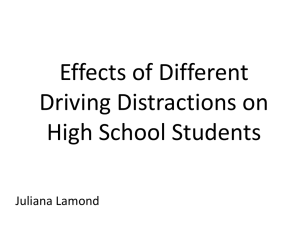Workplace distractions unbound—on the role of job control
advertisement
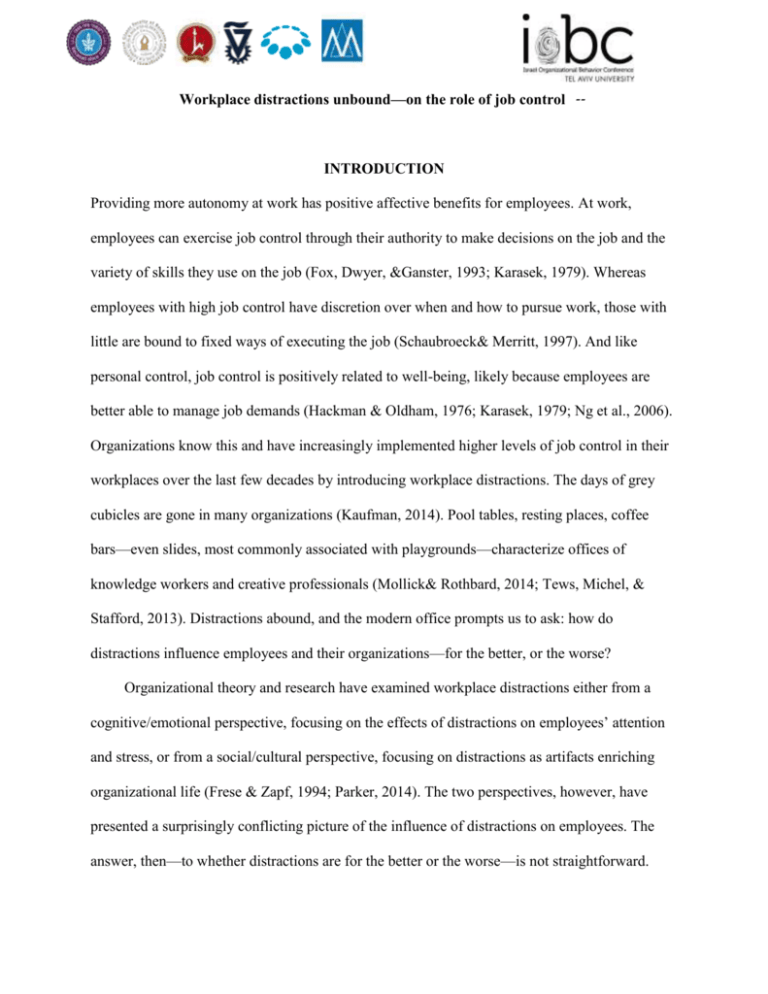
Workplace distractions unbound—on the role of job control -- INTRODUCTION Providing more autonomy at work has positive affective benefits for employees. At work, employees can exercise job control through their authority to make decisions on the job and the variety of skills they use on the job (Fox, Dwyer, &Ganster, 1993; Karasek, 1979). Whereas employees with high job control have discretion over when and how to pursue work, those with little are bound to fixed ways of executing the job (Schaubroeck& Merritt, 1997). And like personal control, job control is positively related to well-being, likely because employees are better able to manage job demands (Hackman & Oldham, 1976; Karasek, 1979; Ng et al., 2006). Organizations know this and have increasingly implemented higher levels of job control in their workplaces over the last few decades by introducing workplace distractions. The days of grey cubicles are gone in many organizations (Kaufman, 2014). Pool tables, resting places, coffee bars—even slides, most commonly associated with playgrounds—characterize offices of knowledge workers and creative professionals (Mollick& Rothbard, 2014; Tews, Michel, & Stafford, 2013). Distractions abound, and the modern office prompts us to ask: how do distractions influence employees and their organizations—for the better, or the worse? Organizational theory and research have examined workplace distractions either from a cognitive/emotional perspective, focusing on the effects of distractions on employees’ attention and stress, or from a social/cultural perspective, focusing on distractions as artifacts enriching organizational life (Frese & Zapf, 1994; Parker, 2014). The two perspectives, however, have presented a surprisingly conflicting picture of the influence of distractions on employees. The answer, then—to whether distractions are for the better or the worse—is not straightforward. Accordingly, we attempt to address the question by integrating the ostensibly conflicting ideas about role of distractions with the concept of job control. We propose the idea that employees experiencing high degrees of job control are more likely to be affected by distractions than those with low levels(Fishbach & Trope, 2005; Loewenstein, 1996). In contrast to existing research, we also propose that higher levels of job control do not necessarily imply affective benefits. Distractions might offer pleasant temporary breaks for those employees that have positive views on distractions and high job control, regaining energy for further pursuit of their tasks, thus relieving rather than fueling stress(Sonnentag, 2001; Trougakos, Hideg, Cheng, & Beal, 2014). Distractions can also serve as tempting distractionsthat require inhibition for those employees who have high job control but view distractions less positively, which can be cognitively depleting and thus reduce an employees’ ability to regulate their emotions(Baumeister & Vohs, 2007; Muraven & Baumeister, 2000). As depicted in Figure 1, we suggest that employees’ level of distress and emotional exhaustion—and consequentially their likelihood to leave the organization—is determined by the interaction of these variables. We test the model with multi-source, multi-time point data, obtained over the course of more than half a year at the UK offices of a global digital media agency (n=213, response rate 38.1%). ---------------------------------------------------Insert Figure 1 about here ---------------------------------------------------NOUTSUUDIRNDNSUSTUUSER Higher perceived levels of workplace distractions are associated with higher levels of emotional exhaustion for some employees, but not all. Those who view distractions positively, and who have high levels job control,experience higher levels of well-being. We find a significant three- way interaction between job control x perceived levels of distractions x positive views on distractions on emotional exhaustion (β = -.21, p< .01), explaining 4% additional variance in emotional exhaustion. The slope of job control, under the condition that perceived levels of distractions are high and positive views on distractions are low, is positive but not significant (B = .13, ns.).According to the theoretical framework, among those employees who view distractions less positively, the positive association between job control and well-being is absent.The slope of job control on emotional exhaustion is significant and negative, when both perceived levels of distractions and positive views on distractions are high (B = -.24, p< .01). This is, according to the theory, because employees benefit from cognitive replenishment incurred by engaging in inherently pleasurable activities or activities that act as brief breaks. These relationships have important downstream consequences: those employees who are able to indulge in distractions are less likely to leave the company. Under the condition that both perceived levels of distractions and positive views on distractions are high, the slope differs significantly from the main effect (t[202] = -2.113, p < .05), indicating a significantly higher reduction in emotional exhaustion than the main effect of job control. The present paper offers important implications for theorizing about distractions in the workplace. First, we provide evidence that distractions—as tempting activities—may act not only as obstacles to task pursuit, and thus a source of exhaustion, but also as a means to replenish cognitive resources in the service of task pursuit, and hence as a source of well-being. Second, our results invite more nuanced theorizing about the effectiveness of rendering the workplace more engaging to increase employee well-being. Overall, our results help reconcile conflicting ideas about the emotional and behavioral effects of distractions in the contemporary workplace. D NOCONORSOU Baumeister, R. F., & Vohs, K. D. (2007). Self-regulation, ego depletion, and motivation. Social and Personality Psychology Compass, 1, 1–14. Fishbach, A., & Trope, Y. (2005). The substitutability of external control and self-control. Journal of Experimental Social Psychology, 41(3), 256–270. doi:10.1016/j.jesp.2004.07.002 Frese, M., & Zapf, D. (1994). Action as the core of work psychology: A German approach. In H. C. Triandis & M. D. Dunnette (Eds.), Handbook of Industrial and Organizational Psychology (2nd ed., pp. 271–340). Palo Alto, CA. Loewenstein, G. (1996). Out of Control: Visceral Influences on Behavior. Organizational Behavior and Human Decision Processes, 65(3), 272–292. doi:10.1006/obhd.1996.0028 Muraven, M., & Baumeister, R. F. (2000). Self-regulation and depletion of limited resources: Does self-control resemble a muscle? Psychological Bulletin, 126, 247–259. Parker, S. K. (2014). Beyond Motivation: Job and Work Design for Development, Health, Ambidexterity, and More. Annual Review of Psychology, 65, 661–691. Sonnentag, S. (2001). Work, Recovery Activities, and Individual Well-Being: A Diary Study. Journal of Occupational Health Psychology, 6(3), 196–210. Trougakos, J. P., Hideg, I., Cheng, B., & Beal, D. (2014). Lunch breaks unpacked: the role of autonomy as a moderator of recovery during lunch. Academy of Management Journal, 57(2), 405–421. doi:10.5465/amj.2011.1072 FIGURE 1 Research Model Perceived Levels of Distractions Positive Views on Distractions Job Control Emotional Exhaustion Actual Turnover
